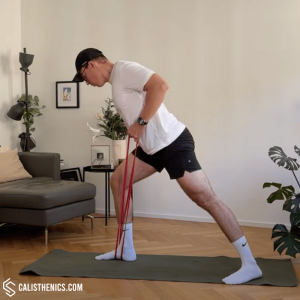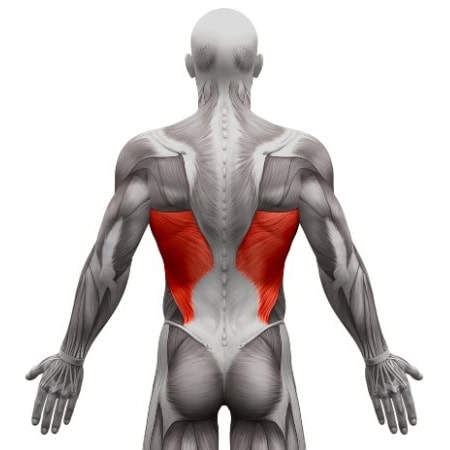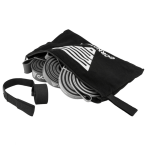Single Arm Resistance Band Bent Over Rows
How to do Single Arm Resistance Band Bent Over Rows?
Single-arm resistance band bent over rows are a unilateral upper-body exercise that targets the back, shoulders, and arms, imitating the movement of a single dumbbell row. In this variation, one side of the resistance band is anchored under the foot, while the other end is pulled toward the torso with one hand. This exercise helps correct muscle imbalances by working each side independently, improving back strength, stability, and core engagement. It’s an effective alternative to traditional weight rows, particularly when working out at home or traveling.
Steps to Perform a Proper Single-Arm Resistance Band Bent Over Row:
1. Anchor the Resistance Band Under Your Foot:
• Stand with feet hip-width apart, anchoring the middle of the resistance band securely under one foot (the same side as your working arm).
• Hold the other end of the band in your hand, ensuring there is slight tension in the band when your arm is extended toward the ground.
2. Set Your Stance and Position:
• Step back slightly with the opposite leg (the one not anchoring the band) for stability.
• Bend your knees slightly and hinge at the hips to lower your torso forward, maintaining a straight back and a slight angle of about 45 degrees.
• Place your non-working hand on your thigh or a sturdy surface for additional support and stability.
3. Engage Your Core and Maintain Proper Alignment:
• Keep your back flat, core engaged, and chest lifted to avoid rounding your spine.
• Ensure your shoulder is set back and down, avoiding any shrugging during the movement.
4. Pull the Band Toward Your Torso:
• Exhale as you pull the band up toward your torso, leading with your elbow and keeping it close to your body.
• Squeeze your shoulder blade toward your spine as you pull, engaging your back muscles fully. Aim to bring your hand just below your ribcage.
5. Control the Descent:
• Inhale as you slowly release the tension in the band, extending your arm back to the starting position.
• Keep tension in the band throughout, stopping just before your arm is fully straight to maintain continuous engagement in your back muscles.
6. Switch Sides:
• Complete the desired number of repetitions on one side, then switch to the other arm and repeat the movement.
Benefits of Single-Arm Resistance Band Bent Over Rows
• Corrects Muscle Imbalances: Working one arm at a time helps identify and address any muscle imbalances, promoting balanced strength development.
• Improves Core Stability: The unilateral movement requires core engagement to stabilize the torso and prevent rotation, building core stability.
• Builds Functional Upper Body Strength: The rowing motion strengthens the muscles involved in pulling, enhancing functional strength for daily activities.
• Improves Posture: By strengthening the muscles that retract the shoulder blades, this exercise can improve posture and counteract the effects of prolonged sitting or slouching.
• Portable and Convenient: With only a resistance band required, this exercise can be performed anywhere, making it ideal for home workouts or travel.
• Joint-Friendly Resistance: Bands provide smooth, controlled resistance that is gentle on the joints, making this exercise accessible for all fitness levels.
• Enhances Mind-Muscle Connection: Working one side at a time improves focus on the target muscles, strengthening the mind-muscle connection and ensuring proper activation.
Common Mistakes to Avoid
• Rounding the Back: Keep your back straight by engaging your core and hinging at the hips. Avoid rounding your back, which can strain the lower spine.
• Using Momentum: Avoid swinging your body to lift the band. Focus on slow, controlled movements for maximum muscle engagement.
• Shrugging the Shoulders: Keep your shoulder down and avoid shrugging toward your ear, which can strain the neck and reduce back activation.
• Twisting the Torso: Keep your torso stable and avoid rotating as you pull. The movement should come from your arm and shoulder blade, not from your body twisting.
• Inconsistent Tension: Avoid letting the band go slack at the bottom by maintaining slight tension throughout the movement.
Tips for the proper execution of Single Arm Resistance Band Bent Over Rows
Engage the Core: Keep your core tight to stabilize your torso and protect your lower back from strain.
Maintain a Neutral Spine: Keep your back straight and avoid rounding. Focus on hinging at the hips rather than bending at the waist.
Squeeze the Shoulder Blade: Focus on pulling with your back muscles by squeezing your shoulder blade toward the spine, ensuring proper activation of the back muscles.
Control the Movement: Avoid using momentum; perform the row slowly and with control to maximize muscle engagement.
Breathing: Exhale as you pull up and inhale as you release down, maintaining stability and focus throughout the movement.
Muscles worked when doing Single Arm Resistance Band Bent Over Rows
Primary Muscles:
•Latissimus Dorsi (Lats): The primary back muscle targeted, responsible for pulling the arm back and down.
•Rhomboids: Located between the shoulder blades, the rhomboids help retract the scapula, pulling the shoulder blade toward the spine.
•Trapezius: The middle trapezius helps stabilize and move the shoulder blades during the rowing movement.
Secondary Muscles:
•Rear Deltoids: The back of the shoulder assists in lifting and stabilizing the arm as you row.
•Biceps: Assist with elbow flexion during the pulling phase.
•Forearms: Engage to maintain a firm grip on the band.
•Core: Engages to stabilize the torso and prevent rotation or leaning during the movement.
•Lower Back: The erector spinae muscles support spinal alignment and help maintain proper posture.
Primary Muscle(s):
Secondary Muscle(s):

Rear delt

Trapezius
Adjust the difficulty of Single Arm Resistance Band Bent Over Rows
How to make Single Arm Resistance Band Bent Over Rows harder?
How to make Single Arm Resistance Band Bent Over Rows easier?
How to make Single Arm Resistance Band Bent Over Rows harder?
To make Single Arm Resistance Band Bent Over Rows harder:
-
Use a Heavier Resistance Band: Increase the difficulty by using a band with more resistance, further challenging your back, shoulders, and arms.
-
Increase Range of Motion: Stand with feet closer together to increase the length of the band, adding tension throughout the row.
-
Add a Hold at the Top: Pause for 2-3 seconds at the top of the row to increase time under tension and maximize muscle engagement.
-
Slow Down the Eccentric Phase: Take extra time lowering the band to the starting position, engaging the muscles during the eccentric (lengthening) phase.
How to make Single Arm Resistance Band Bent Over Rows easier?
To make Single Arm Resistance Band Bent Over Rows easier:
-
Use a Lighter Resistance Band: Start with a band that provides less resistance, making it easier to perform the row with good form.
-
Limit Range of Motion: Instead of pulling the band all the way to your ribcage, pull only halfway to reduce intensity.
-
Reduce Repetitions: Start with fewer repetitions (e.g., 8-10) and increase gradually as you build strength and confidence.






